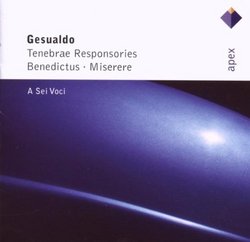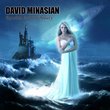| All Artists: Carlo Gesualdo, A Sei Voci Title: Gesualdo: Tenebrae Responsories; Benedictus; Miserere Members Wishing: 0 Total Copies: 0 Label: Warner Classics Original Release Date: 1/1/2007 Re-Release Date: 5/22/2007 Genre: Classical Styles: Opera & Classical Vocal, Chamber Music, Historical Periods, Classical (c.1770-1830) Number of Discs: 2 SwapaCD Credits: 2 UPC: 825646278220 |
Search - Carlo Gesualdo, A Sei Voci :: Gesualdo: Tenebrae Responsories; Benedictus; Miserere
 | Carlo Gesualdo, A Sei Voci Gesualdo: Tenebrae Responsories; Benedictus; Miserere Genre: Classical
|
Larger Image |
CD DetailsSimilar CDs
|
CD ReviewsShadow Voices Giordano Bruno | Wherever I am, I am. | 07/01/2009 (4 out of 5 stars) ""A Sei Voci" is one of the more eccentric ensembles in 'Early Music' today. Eccentricity might be taken for adventuresomeness, but not all of their experiments succeed. They've recorded the fabulous 'Miserere' by Gregorio Allegri using a written-out set of ornaments that remind me of the toys called 'transformers.' They produced two CDs of Josquin masses using a choir of children to sing the superius, with perhaps interesting but musically incoherent results.
It might seem that eccentricity would suit the music of Carlo Gesualdo (1561-1613), but in my opinion, the composer prince built in enough expressive originality without mandating any extra eccentricity from mere performers. The 'Six Voices' have chosen to sing these Tenebrae Responsories with a thin, slightly withheld "head voice" throughout. The effect, to my ears, is expressively penitential some of the time, but also stifled much of the time. Such a timbre would seem more suitable if Gesualdo had been French rather than Italian. If the six men sang this way in a side-chapel of a cathedral, without mikes, they'd be heard only by each other. A more objective criticism is that the tuning is not flawless. Gesualdo is notoriously hard to sing, with all his oddly prepared dissonances and his strange chromaticism. However, the chromatics only achieve poignancy when the consonances are perfect. If you listen carefully to the chords with which the polyphony resolves, at the ends of sections, you'll hear what I mean even if you are not yourself a singer. Those chords are preponderantly simple triadic majors or minors, and A Sei Voci often fails to 'nail' them. There are virtues to this performance, nevertheless. The ensemble is well-balanced and transparent enough to reveal the inner voices at all times. The rhythmic interpretation is excellent. I can imagine finding this performance 'spiritually' uplifting and meditative. Of all Gesualdo's works, the Tenebrae Responsoria have been most often recorded, and because they are so musically curious, every performance sounds wildly different. The Hilliard Ensemble recorded all three evenings' Responses - Thursday, Good Friday, Holy Saturday -as A Sei Voci has done. Andrew Parrot and the Taverner Consort have recorded the Responses for Good Friday, in the context of the plainchant antiphons, psalms and lectios, giving a sounder idea of what this music was about and how it might have been heard in 1611. Philippe Herreweghe and the Ensemble Vocal Européen have recorded just the responsories for Sabbato Sancto, but have included four very plangent motets by Gesualdo, and an impressive 'Requiem' by the modern composer Sandro Gorli (b. 1948). For one reason or another, I find myself more likely to listen to any of those three recordings than to the CDs by A Sei Voci." |

 Track Listings (13) - Disc #1
Track Listings (13) - Disc #1

